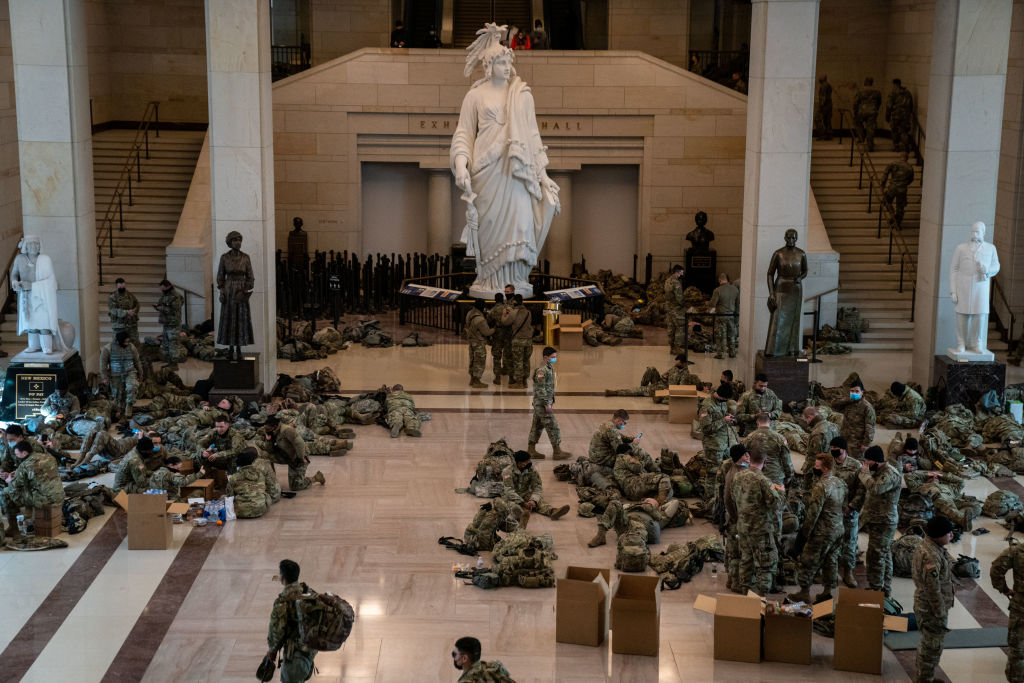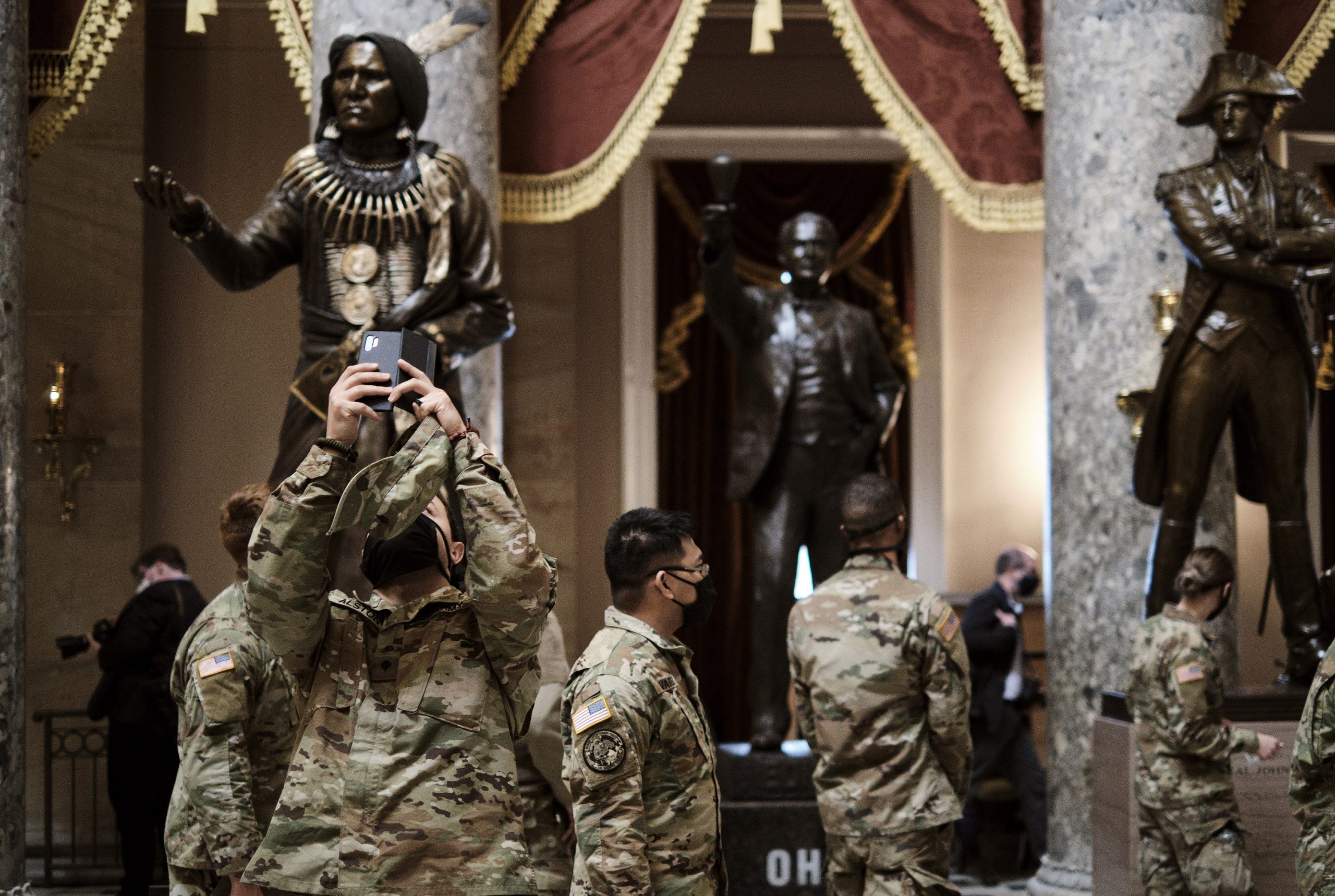Casting the Republic in White
You are looking at freedom here, as cast by the United States (fig. 1). Beneath a plaster cast of Thomas Crawford’s Statue of Freedom, the allegorical female figure who adorns the US Capitol dome, troops gather in the United States Capitol Visitor Center to protect Congress. This photograph appeared a week after the harrowing attempted coup at the Capitol, and, as versions of it circulated coast-to-coast, the image of the Statue of Freedom surrounded by National Guardsmen and women offered stability and calm to a divided nation. It was the antithesis of the images of seditionists and rioters invading, looting, and screaming that dominated the news media in the days following the insurrection. The Statue of Freedom is protected by and protecting these troops, standing vigilant over the brave, personifying the pledge of allegiance to a republic, one and indivisible, now in crisis. Consider her gladiatorial calm and the fact that she stands at rest, but armed and alert. We see the symbiosis between this goddess of the republic and the troops brought into her temple to aid in her defense.

Now look again. Crawford’s finished sculpture, first in plaster and then in bronze, merged republican imagery, Greco-Roman fantasy, and American symbolism (note the eagle helmet and eagle plumes).1 The inescapable whiteness of the visitor center’s plaster cast, however, reveals important truths that her bronze sister, standing atop the Capitol dome, obscures. Bone-white and surging from the photo frame, she beckons viewers, and troops, to come to her defense precisely because the United States has allegorized freedom, and the figure of Columbia, most often as a White woman.2 She presides over the paintings, friezes, prints, and sculptures hanging on the walls or carved into the building’s stone that celebrate the histories upon which this nation is founded and are molded into the frame of the building: Native American and Indigenous removal and erasure.
There is another ugly truth about the United States embedded in this image of Statue of Freedom. Those who see Crawford’s statue and the eagle helmet often cast the Statue of Freedom as a Native woman, part of a triumphalist US script that acknowledges lost Indigenous roots in a glorious republican present. That the statue can occupy this imaginary reinforces the decades of erasure preceding the painfully slow entry of Native history and individuals into the pantheon of US history. And even then, Native actors are most often relegated to roles in a semi-invisible, supporting cast. We relegate or ignore Native history as part of the distant past, instead of considering it a part of our present, at our own peril.
In a second photograph, taken the same week in January, a Virginia National guardsman memorializes his unprecedented presence in Statuary Hall (fig. 2.). He aims his smartphone at the elaborate rotunda ceiling—or possibly at Carlo Franzoni’s sculpture Car of History—but the image of him captured by Redux photographer T. J. Kirkpatrick draws the viewer’s attention to Benjamin Victor’s 2019 sculpture of Ponca chief Manchú-Nanzhín (also known as Chief Standing Bear) positioned behind him.3 The life-size bronze sculpture of Manchú-Nanzhín stands adjacent to a bronze statue of Ohio’s Thomas Edison (near right), who was the inventor of the light bulb as well as being a proponent of racial phrenology. At the next column (far right), Tennessee’s John Sevier—a state founder and an enslaver who built and burnished a military reputation for fighting, and killing, Indians—stands, eyes fixed on the back of Manchú-Nanzhín. To take Manchú-Nanzhín ’s vantage point, he is in poor company.

The Capitol Building’s National Statuary Hall Collection, which contains one hundred statues, is comprised of sculptures and casts donated by individual states to honor persons notable in their history. Today, only seven statues from the fifty states celebrate Native individuals’ contributions to this nation, and only two of those stand in Statuary Hall. Two statues were gifted between 1910 and 1969; five were presented after 2000; and only one was sculpted by a Native artist, Cliff Fragua of Jemez Pueblo.4 All represent Native men and women who fought for rights, like Manchú-Nanzhín, who, in 1879, won United States, ex rel. Standing Bear v. George Crook, which challenged the US government’s position of Indians as “neither a citizen, nor a person.” This ruling established that “an Indian is a person within the meaning of the laws of the United States” and accordingly is entitled to civil rights under the Fourteenth Amendment.5 The Indian Citizenship Act of 1924 certified these protections and formally incorporated Native individuals into the republic. The statues of Native people in the Capitol collection attest to the essential roles Indigenous people have played and continue to play in forcing the United States to live up to its ideals, but in this collection they are conscripted into a national mythos of democratic freedom.
Statues speak volumes, and so do the few words used to unveil and dedicate them. At the induction of the Manchú-Nanzhín sculpture into Statuary Hall in 2019, House Minority Leader Kevin McCarthy attempted an act of historical inclusion, saying, “I promise: you will stop here, because . . . you’ll look at that skin tone and wonder why does he sit in this hall, what is the story behind Chief Standing Bear.”6 Manchú-Nanzhín has the same skin tone as Sevier and Edison, since they are all bronze statues. So, for whom are McCarthy’s presumably revelatory comments intended? For all Americans, or just for his Republican constituents? McCarthy’s statement assumes that Capitol visitors expect to see White famous faces. Even as the dispossessed, the disinherited, and the erased edge back into the national narrative, McCarthy seeks to obliterate them once more by gesturing toward the abundant iconographic program of the US Capitol: the only people expected to freely traverse these halls, and to anticipate their own inclusion, are White Americans.
Returning to the Statue of Freedom, she is depicted as an idealized White woman, brave, armed . . . and passive. Weighed down by the heavy drapery imposed over her figure, she is rendered incapable of vigorous action. She is the patriarchal dream of a more perfect union, and she upholds the protections historically and currently afforded to White women, justifying even violence in their defense, particularly against the imagined threats of non-White individuals. Neither the Statue of Freedom nor the police were able to protect the building or its occupants from the mob’s screams of “Where’s Nancy?” Nor did they prevent the ripping out of panic buttons in Rep. Ayanna Pressley’s office. The Statue of Freedom did not shield Rep. Debra Haaland, now confirmed as the first Native American secretary of the interior in United States history, from charges of being radical for defending ancestral homelands of Native nations. And Secretary Haaland’s enrollment in Laguna Pueblo, in addition to her US citizenship status, further marks her as an object of suspicion among many. These are reminders that Black and Native women still do not benefit from the same securities afforded their White peers.
Three successive Wednesdays in January offered a coup, an impeachment, and an inauguration on the Capitol grounds. At the inauguration of President Joseph R. Biden, a performance attempting a return to the peaceful transition of power, actress Jennifer Lopez sang Woody Guthrie’s “This Land is Your Land” without recognizing that the US Capitol sits on Nacotchtank, Anacostan, and Piscataway land. The stones of the US Capitol make the temple of American democracy. How did the stones get there and whose labor made the building? Whose land was taken for the purpose and whose gender supplies the crowning trope above the dome and in Statuary Hall below it? These lives make all the difference to the real story of this building and of this country. Forced by the events of January 6, 2021, to confront what the US Capitol means and continues to signify, we must reckon with the question of who is included in this spirit of freedom and how. How do we recast freedom? By facing the truth and the skeletons in our past. The bones of our nation are broken and will only reknit when we apply the correctives of historical truth.
June 23, 2021: An earlier version of this article gave a different title for the Statue of Freedom. This has been changed to reflect the preferred title of the Office of the Architect of the Capitol.
Cite this article: Christian Ayne Crouch, “Casting the Republic in White,” in Art and Politics in the US Capitol, special section, Panorama: Journal of the Association of Historians of American Art 7, no. 1 (Spring 2021), https://doi.org/10.24926/24716839.11763.
PDF: Crouch, Casting the Republic in White
Notes
- Vivien Green Fryd, Art and Empire: The Politics of Ethnicity in the United States Capitol, 1815–1860 (Athens: US Capitol Historical Society for Ohio University Press, 2001). ↵
- I have chosen to capitalize “White” when using this word in regard to ethnicity. Scholarly publications and media outlets increasingly have adopted the convention of capitalizing the words Native, Indigenous, Black, and, even in some instances, Brown. Given the arguments I present here regarding the naturalization and pervasiveness of the settler colonial gaze, addressing “White” as a construction seems imperative. ↵
- Statuary Hall was established near the end of the Civil War, in 1864, by an act of Congress. The contribution of two statues per state was amended in 2000, allowing states to replace existing gifts. Chris Dunker, “Effort seeks to replace Nebraska statues in US Capitol,” Associated Press, March 3, 2018, https://apnews.com/article/b95a90ee41df44d8b75e55f559f698ac. ↵
- Statues include: Sequoyah (Cherokee, 1917-OK), Will Rogers (Cherokee, 1939-OK); King Kamehamea I (Kanaka Maoli; 1969-HI); Chief Washakie (Salish/Shoshone; 2000-WY); Sakakawea (Shoshone; 2003-ND); Po’pay (Tewa-San Juan Pueblo, 2005–NM); and Sarah Winnemuca (Paiute; 2005– NV). Sculptor Cliff Fragua (Jemez Pueblo) carved fellow Puebloan Po’pay. “Explore the Capitol Campus/Art: Native Americans in Art,” website of the Architect of the Capitol, accessed January 17, 2021, https://www.aoc.gov/explore-capitol-campus/art/native-americans and “Explore the Capitol Campus/Art: Po’pay,” website of the Architect of the Capitol, accessed January 17, 2021, https://www.aoc.gov/explore-capitol-campus/art/popay. ↵
- United States, ex rel. Standing Bear v. George Crook, 25 F. Cas. 695 (D. Neb. 1879) 5 Dill. 453. Nebraska’s 2019 gift replaced a statue of William Jennings Bryan dating to 1937; Jennifer Davis, “Chief Standing Bear and His Landmark Civil Rights Case,” In Custodia Legis (Law Librarians of Congress blog), November 21, 2019, https://blogs.loc.gov/law/2019/11/chief-standing-bear-and-his-landmark-civil-rights-case; “Chief Standing Bear: A Person Under the Law,” Text Text of U.S. Court Library 8th Circuit’s Traveling Display, http://www.lb8.uscourts.gov/pubsandservices/histsociety/neb-chief-standing-bear-text.pdf. ↵
- Niels Lesniewski, “Chief Standing Bear statue welcomed in Capitol, replacing William Jennings Bryan,” Roll Call, September 18, 2019, https://www.rollcall.com/2019/09/18/chief-standing-bear-statue-welcomed-in-capitol-replacing-william-jennings-bryan. ↵
About the Author(s): Christian Ayne Crouch is Associate Professor in the Historical Studies Program, Bard College

